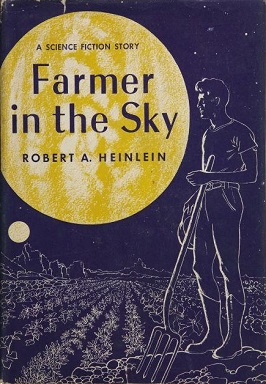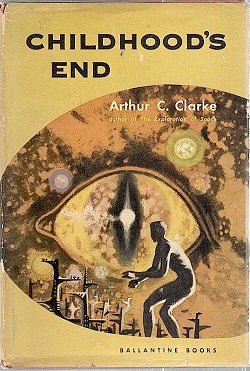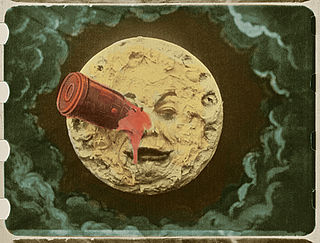
Rocket Ship Galileo, a juvenile science-fiction novel by the American writer Robert A. Heinlein, published in 1947, features three teenagers who participate in a pioneering flight to the Moon. It was the first in the Heinlein juveniles, a long and successful series of science-fiction novels published by Scribner's. Heinlein originally envisioned the novel as the first of a series of books called "Young Rocket Engineers". Publishers initially rejected the script, judging going to the Moon as "too far out".

Farmer In The Sky is a 1950 science fiction novel by American writer Robert A. Heinlein about a teenaged boy who emigrates with his family to Jupiter's moon Ganymede, which is in the process of being terraformed. Among Heinlein's juveniles, a condensed version of the novel was published in serial form in Boys' Life magazine, under the title "Satellite Scout". The novel was awarded a Retro Hugo in 2001.

Childhood's End is a 1953 science fiction novel by the British author Arthur C. Clarke. The story follows the peaceful alien invasion of Earth by the mysterious Overlords, whose arrival begins decades of apparent utopia under indirect alien rule, at the cost of human identity and culture.
Battlestar Galactica is an American science fiction media franchise created by Glen A. Larson. It began with the original television series in 1978, and was followed by a short-run sequel series, Galactica 1980, a line of book adaptations, original novels, comic books, a board game, and video games. A reimagined version aired as a two-part, three-hour miniseries developed by Ronald D. Moore and David Eick in 2003, followed by a 2004 television series, which aired until 2009. A prequel series, Caprica, aired in 2010.

Sam Youd was a British writer best known for science fiction written under the name of John Christopher, including the novels The Death of Grass, The Possessors, and the young-adult novel series The Tripods. He won the Guardian Children's Fiction Prize in 1971 and the Deutscher Jugendliteraturpreis in 1976.
The Space Odyssey series is a series of science fiction novels by the writer Arthur C. Clarke. The first novel was developed concurrently with Stanley Kubrick's film version and published after the release of the film. The second was made into a feature film, released in 1984, respectively. Two of Clarke's early short stories have ties to the series.

UFO is a 1970 British science fiction television series about the covert efforts of an international defence organisation to prevent an alien invasion of Earth. It was created by Gerry Anderson and Sylvia Anderson with Reg Hill, and produced by the Andersons and Lew Grade's Century 21 for Grade's ITC Entertainment company.

3001: The Final Odyssey is a 1997 science fiction novel by British writer Arthur C. Clarke. It is the fourth and final book in Clarke's Space Odyssey series.

First Men in the Moon is a 1964 British science fiction film, produced by Charles H. Schneer, directed by Nathan Juran, and starring Edward Judd, Martha Hyer and Lionel Jeffries. The film, distributed by Columbia Pictures, is an adaptation by screenwriter Nigel Kneale of H. G. Wells' 1901 novel The First Men in the Moon.

The Moon has appeared in fiction as a setting since at least classical antiquity. Throughout most of literary history, a significant portion of works depicting lunar voyages has been satirical in nature. From the late 1800s onwards, science fiction has successively focused largely on the themes of life on the Moon, first Moon landings, and lunar colonization.

Bryan Fuller is an American television writer and producer who has created a number of television series, including Dead Like Me, Wonderfalls, Pushing Daisies, Hannibal, American Gods, and Crystal Lake. Fuller worked as writer and executive producer on the Star Trek television series Voyager and Deep Space Nine; he is also the co-creator of Star Trek: Discovery.
"The Raven" is the 74th episode of Star Trek: Voyager, the sixth episode of the fourth season. The episode was directed by LeVar Burton, and was broadcast on UPN in October 1997.

Subterranean fiction is a subgenre of adventure fiction, science fiction, or fantasy which focuses on fictional underground settings, sometimes at the center of the Earth or otherwise deep below the surface. The genre is based on, and has in turn influenced, the Hollow Earth theory. The earliest works in the genre were Enlightenment-era philosophical or allegorical works, in which the underground setting was often largely incidental. In the late 19th century, however, more pseudoscientific or proto-science-fictional motifs gained prevalence. Common themes have included a depiction of the underground world as more primitive than the surface, either culturally, technologically or biologically, or in some combination thereof. The former cases usually see the setting used as a venue for sword-and-sorcery fiction, while the latter often features cryptids or creatures extinct on the surface, such as dinosaurs or archaic humans. A less frequent theme has the underground world much more technologically advanced than the surface one, typically either as the refugium of a lost civilization, or as a secret base for space aliens.

The First Men in the Moon is a scientific romance, originally serialised in The Strand Magazine and The Cosmopolitan from November 1900 to June 1901 and published in hardcover in 1901, by the English author H. G. Wells, who called it one of his "fantastic stories". The novel tells the story of a journey to the Moon undertaken by the two protagonists: a businessman narrator, Mr. Bedford; and an eccentric scientist, Mr. Cavor. Bedford and Cavor discover that the Moon is inhabited by a sophisticated extraterrestrial civilisation of insect-like creatures they call "Selenites". The inspiration seems to come from the famous 1865 book by Jules Verne, From the Earth to the Moon, and the opera by Jacques Offenbach from 1875. Verne's novel also uses the word "Selenites" to describe inhabitants of the Moon.

Ancient astronauts have been addressed frequently in science fiction and horror fiction. Occurrences in the genres include:
Plymouth is a 1991 science fiction television film that was shown on ABC Network in the same year, as a pilot for a planned series. It was created by Lee David Zlotoff and funded by the American Broadcasting Corporation, Walt Disney and Rai uno radiotelevisione, with Lockheed acting as technical advisors.

Five Against Venus, written by Philip Latham, is a science-fiction novel first published in the United States in 1952 by the John C. Winston Company. Philip Latham was the nom de plume of Robert S. Richardson, a professional astronomer who also provided technical assistance on movies such as Destination Moon and wrote scripts for the Captain Video television series.













